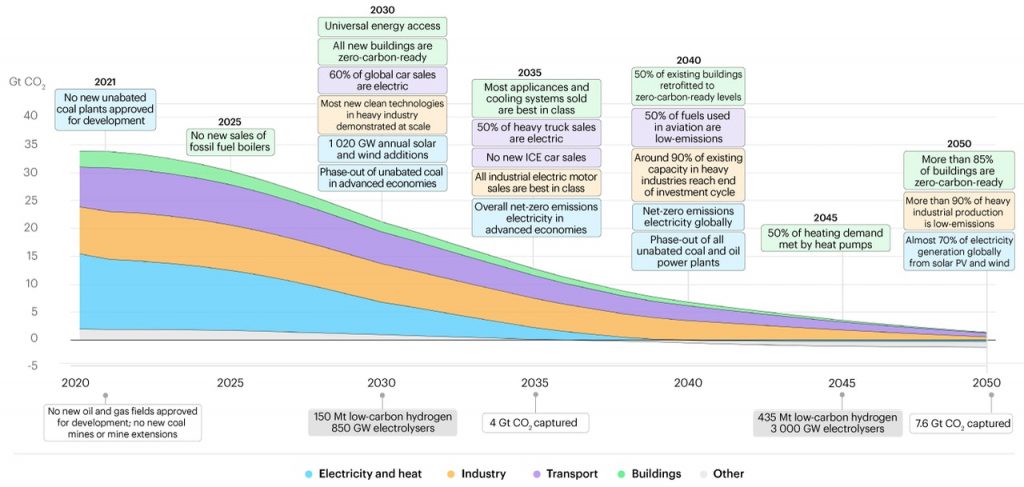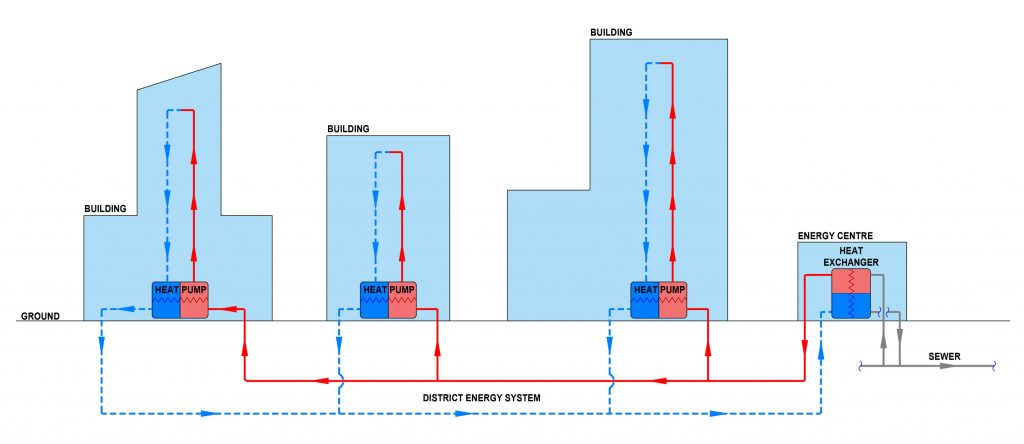The recent issue of the International Energy Agency‘s (IEA) “Net Zero by 2050 – A Roadmap for the Global Energy Sector” has caused some ripples within the industry and construction sectors and it is worthwhile picking out some of the highlights as they relate to the commercial and residential sector. One of the key takeaways is that 50% of heating demand is to be provided by heat pumps by 2045. The latest Intergovernmental Panel on Climate Change (IPCC) report by the United Nation’s advisory body sets the stage for the construction industry to work on these findings of IEA with renewed vigor and innovativeness. This blog presents a pathway towards that end to efficiently implement heat pumps through the use of 5th Generation District Energy (also known as Ambient-temperature District Energy), pioneered by Pinchin..
IEA Net Zero Path to 2050 Timeline

- 2025 – No New sales of fossil boilers
- 2030 – All new buildings to be zero carbon ready
- 2040 – 50% of existing buildings retrofitted to zero carbon levels
- 2045 – 50% of heating demand met by heat pumps
- 2050 – More than 85% of buildings are zero carbon ready
What is 5th Generation District Energy?
5th Generation District Energy Systems (DES) distribute low-grade heat (typically between 10oC and 25oC) to each connected load and upgrade it to the required temperature using heat pumps. Common sources of low-grade heat include wastewater heat recovery or geo-exchange. Other sources of low-grade heat include lakes, sea, waste heat from factories, ice rinks, and even abandoned mine workings. There can also be useful waste heat collected from building chiller plants in cities where well-insulated offices, retail, or data centers operate with year-round air conditioning needs.

Air Source or Water Source Heat Pumps?
Now, it is clear that heat pumps are likely to become a part of life going forward and it is worthwhile looking at how that might impact building design and the design of infrastructure to supply them. It seems to be more or less assumed that a lot of these heat pumps will be air to water type. A heat pump’s ability to also provide cooling in summer by operating in reverse is clearly an advantage. So, what are the drawbacks?
Modest Efficiency
While air-source heat pumps generally have good efficiency, the seasonal coefficient of performance (COP) is significantly reduced in colder climates such as in Ontario and Alberta.
Noise
Air-source heat pumps, while not by any means a noise nuisance will still have similar noise levels to an air-cooled condenser of an air-conditioning system, somewhere around 50dB. If you multiply that by every home in say a townhouse development having an air to water (or air to air) heat pump, the noise levels may become a bit more noticeable as units cut in and out or operate constantly in winter.
Aesthetics & Space
While most traditional systems such as hot water heaters and boilers can be effectively hidden away in a building, an air-source heat pump has to be mounted externally. As land available for building reduces and densification is encouraged by planning regulations, the space to effectively hide these units while giving air access around them creates issues for architects and engineers alike. It is impractical to have individual externally-mounted heat pump condensers on high-rise buildings. Even for centralized air-source systems, it is a challenge to have enough rooftop space to meet the full load of a tall building.
The Role of 5th Generation District Energy Systems
It is generally agreed that a better alternative to air source is the water source heat pump. However, the installation cost is generally higher, especially for ground-source variant because of the cost to install a geo-exchange borefield.
So, what if we could have all the advantages of a heat pump and do away with the higher installation costs? The answer is 5th Generation District Energy.
Cost
The costs for the geo-exchange or other energy source and distribution piping are borne by the district energy provider so the developer can reap the benefits of geo-thermal energy without substantial upfront cost. Additionally, the neat thing about 5th Generation DES is that it allows energy to be extracted from and rejected to the same district energy distribution loop. Hence the same heat pump used for heating can be run in reverse to provide cooling at no additional cost. Fifth generation DES can eliminate the need for chillers and cooling towers at each building.
Efficiency
Many 5th Generation systems use geo-exchange or sewer heat and thus allow water source heat pumps to access more stable and higher average source temperatures. This results in better efficiency in extreme cold weather conditions (such as those in Ontario and Alberta) or extreme heat (like the recent heat wave observed in western Canada). This helps complement the drive for electrification especially in areas where grid capacity poses certain challenges.
Energy Sharing
For developments with some year-round cooling loads, the district energy loop can provide a means for energy sharing between buildings. Heat rejected by one building in predominantly cooling mode can be used by another which requires heating.
Noise
Water source heat pumps are installed internally with no noise-producing outdoor components required!
Aesthetics & Space
No components installed externally saving balcony and rooftop space!
5th Generation DES has become ever more relevant to tackling climate change! One of the latest project in Canada which shows growing interest is the geo-exchange based Blatchford District Energy Sharing System (DESS) in Edmonton (AB), that has been in operation since 2019. Some other notable examples include the Alexandra District Energy Utility in Richmond BC) and the Westhills Community Energy System (CES) in Victoria (BC). 5th generation DES is poised to play a significant role in helping communities meet their sustainability goals as set out by International Energy Agency.
If you would like to learn more about 5th Generation District Energy Systems and how our Mechanical Engineering & Design (MEC) Group can help you and your business reach your sustainability goals, contact your local Pinchin office, or contact one this articles MEC contributors:
Graeme Terris,
National Practice Leader, MEC Group
Andrew Byrnes,
Senior Project Manager, MEC Group
Shahrukh Shahid,
Project Engineer, MEC Group